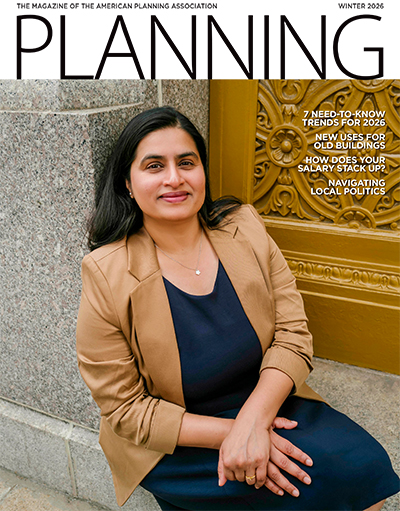July 11, 2024
This story is part of the "Tech Tools" series, created in collaboration with APA's Technology Division. From anticipating uncertainty to improving mobility and building digital twins, we highlight topical datasets, applications, and other tools that help planners understand — and better plan for — their communities. The authors thank Derrick Frese from the Arbor Day Foundation and Shane Feyers from the U.S. Forest Service for their contributions to this article.
At the heart of urban conservation planning is the concept of green infrastructure — natural and seminatural features that provide ecological, social, and economic benefits. From parks and urban forests to green roofs and permeable pavement, green infrastructure has been celebrated for its effectiveness in mitigating urban heat island effects, managing stormwater, enhancing biodiversity, and improving the overall quality of life in communities.
Recommended digital tools
The utility of green infrastructure in urban areas is increasingly apparent, though its integration into planning practice is complex and challenging, in part because of insufficient information and a lack of clarity on appropriate sources of data. At the same time, many tools and technologies offer promising solutions and allow planners to gain more specific insights, quantify value, and inform impact on important issues. Leveraging the right tools and data sources allows planners to be more strategic in their approach to future interventions, more competitive in obtaining grant funding for projects, and ultimately to achieve more positive and sustainable outcomes for communities.
The tools below, ranging from utilities for geospatial analysis to data visualization, can empower planners and other stakeholders in the quest for green infrastructure.

Image courtesy of iTree.
i-Tree
Data | Visualizer | Analysis | Application
The i-Tree suite of tools is created and maintained by a public-private partnership that includes the U.S. Forest Service, the Arbor Day Foundation, and the Davey Tree Expert Company. These tools allow users to identify the benefits (like air pollution reduction) of planting trees in their communities at various scales. For instance, the i-Tree Canopy application supports tree canopy assessments and illustrates changes over time. Nonprofit organizations, consulting companies, and governments alike use this tool to understand tree inventory and canopy coverage — as well as to coordinate tree-planting activities.
Cost: Free
Resource formats: Geospatial data, tabular data, static and interactive maps
Coding skills required: No

Image courtesy of LEARN.
LEARN Tool
Data | Visualizer | Analysis | Application
The U.S. Community Protocol's Land Emissions and Removals Navigator (LEARN) is an interactive web mapping tool developed to help communities estimate the impact of local greenhouse gas (GHG) emissions on their forests and trees. The platform can calculate GHG impacts in a region over time and generate detailed, downloadable reports about emissions and carbon removal factors for trees located outside of forests, which are based on data collected in representative urban areas. Built as a partnership between ICLEI - Local Governments for Sustainability, Global Forest Watch, and the Woodwell Climate Research Center, this is a great tool for any stakeholder to access local-level carbon data.
Cost: Free
Resource formats: Geospatial data, PDF reports
Coding skills required: No

Image courtesy of ArcGIS Living Atlas of the World.
ArcGIS Living Atlas of the World: The Green Infrastructure Collection
Data | Analysis | Application | Aggregator
The Green Infrastructure Collection of the ArcGIS Living Atlas of the World includes demographic and other relevant data along with valuable imagery to inform a green infrastructure strategy. A combination of publicly available and user-contributed sources, the data is categorized into ecological, cultural, scenic, and conservation assets as well as hazard zones and boundaries. Viewing the resources is free, but download, analysis, and other actions require a subscription.




